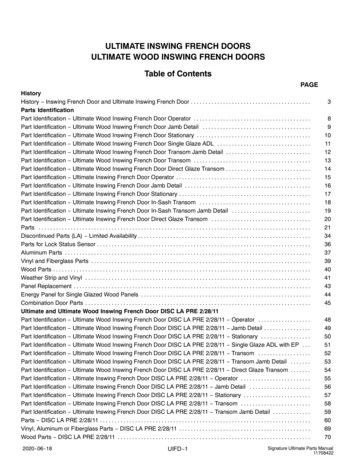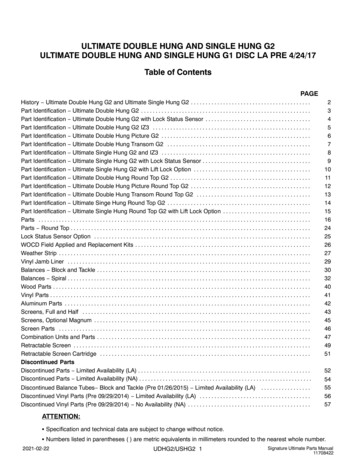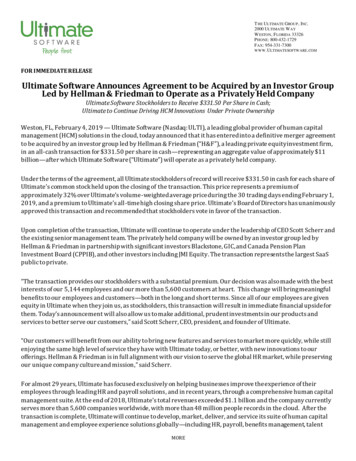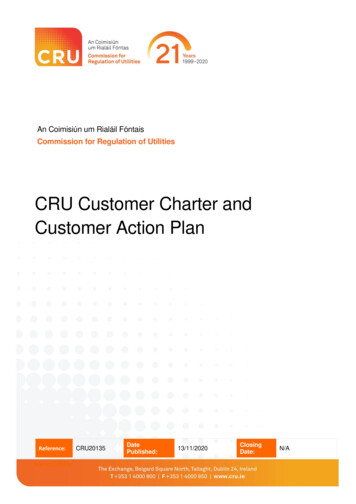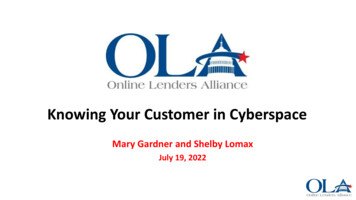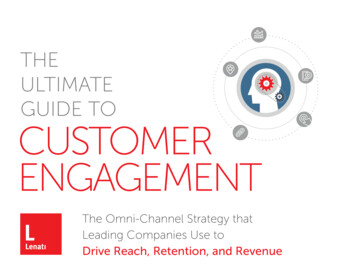
Transcription
THEULTIMATEGUIDE TOCUSTOMERENGAGEMENTThe Omni-Channel Strategy thatLeading Companies Use toDrive Reach, Retention, and Revenue
EXECUTIVE SUMMARYThis is your customer engagement toolkit: a comprehensive starting pointin developing the right approach for your company.In today’s marketing climate, a well-thought-out customer engagement strategy is essential. Customers arethe ones driving brand interactions, with more power than ever before to choose how and when to engagewith the brand. So how do we look beyond stand-alone, one-time brand experiences to create the kind ofongoing, deep engagement that customers will want to seek out and maintain on their own?Leading companies respond to this complexproblem by shaping their customers’ engagementjourney purposefully, with programs tailored tocustomer needs on any channel they might choose.To help your brand reap the benefits of a strong customer engagement program, this guide will break downwhy customer engagement matters, how to recognize it, and the steps required to design and deliver asuccessful omni-channel engagement strategy.2
CONTENTSPART ONE: WHY CUSTOMER ENGAGEMENT MATTERSEngaging customers with your brand has many benefits, regardless of your industry, positioning,and primary channels. From driving increased sales to strengthening retention and reach, customerengagement delivers results.PART TWO: THE CUSTOMER ENGAGEMENT LADDERCustomer engagement behaviors are any non-transactional “touches” made with a brand. Thesemoments happen when customers develop emotional and psychological engagement with yourbrand and decide to invest their time and energy in you. Once engaged, customers must be moved“up the engagement ladder” from low-effort to high-effort behaviors that are mutually beneficial tobrands and customers alike.PART THREE: HOW TO DEVELOP YOUR ENGAGEMENT STRATEGYThere are five key steps to developing an effective engagement program.I. ALIGN THE ORGANIZATION — Kick off the development of your engagement strategy by gaining buy-infrom executives and cross-functional teams.II. DESIGN YOUR STRATEGY — Connect engagement program tactics and the strategic business outcomesdesired. Leverage insights from research and analytics to design for maximum impact and ROI.III. DEVELOP THE RIGHT TACTICS — Develop tactics to support your strategy using Lenati’s best practicesfor engagement in every applicable channel.IV. PILOT AND SCALE — Support the successful execution of your engagement program by taking a “testand learn” approach to piloting and scaling.V. MEASURE AND MANAGE — Manage customer health and engagement program results usingengagement scores, interactive dashboards, and lifetime engagement values.3
ities ThatDeliver BusinessResults4
WHY CUSTOMER ENGAGEMENT MATTERSTHE BOTTOM LINEResearch hasdemonstrated thatengaged customersbuy more, driveincreased word ofmouth, and are moresatisfied and loyal.2, 6, 35Additionally, positively engagedcustomers have a higher CustomerLifetime Value (CLV) than nonengaged customers. Word of mouthalone may add up to 40% to the CLVof an engaged customer. 2HIGHLY ENGAGED CUSTOMERS GAIN MOREVALUE FROM YOUR CORE OFFERING and will devotetheir own time and effort to creating value on behalf of your brand, whichcan lead to co-designed products or services, user-generated content,grassroots publicity, and broader reach.ENGAGEMENT TACTICS CAN ALSO INFLUENCENEW CUSTOMER ACQUISITION. Engaged consumers whoare not yet customers are high-likelihood acquisition targets. Your brandshould be tracking whether someone is an end-user of your product oris actively consuming content, but not yet making purchases. On the flipside, negatively engaged customers can erode brand value and deter newcustomers. This makes monitoring and managing customer engagementessential, both to growing an existing customer base and acquiringnew customers.96% of marketers agree that customerengagement drives business performance.Source: Lenati Loyalty Driver Modeling Poll, 20175
WHY CUSTOMER ENGAGEMENT MATTERSCUSTOMER ENGAGEMENT DELIVERS RESULTSCUSTOMER ENGAGEMENT PROGRAMActivities that generate psychological andbehavioral engagementDIRECTRESULTS Lift in sales and retention Lift in satisfaction Value created by customers onbehalf of brand (e.g., throughuser-generated content)SECONDARYRESULTS Amplified reach through socialshares, recommendations, andword of mouth Increased loyaltyLONG-TERMRESULTS Higher likelihood of customersstaying engaged or re-engaging Cumulative effect on loyaltyand purchasing as a result ofmultiple engagements Higher Customer Lifetime Value(CLV)6
WHY CUSTOMER ENGAGEMENT MATTERSCROSS-CHANNELIMPACTSCUMULATIVELONG-TERM EFFECTSCustomer engagement drives benefits across everychannel where a brand does business—regardless of thechannel with which customers engage. For example,customers do not distinguish between Nike in a storeand Nike on an app; they just perceive Nike. Customerengagement happens across all brand channels, outsideowned brand platforms, and even in the mind of thecustomer. A good customer engagement strategy willleverage all avenues to build and deepen engagement.Engagement has both short- and long-term effects oncustomer behavior, with a cumulative positive impact.Engagement not only drives immediate impact onpurchase probability, satisfaction, and loyalty, but it alsoincreases the likelihood of future engagement. Thiseffect builds over time. In the short term, an organizationthat aligns to deliver a unified customer engagementstrategy will benefit from an immediate lift in reach andsales. Over the long term, it will gain even more as itmoves customers up the engagement ladder.Driving mobile app engagement has been shown to significantly increaseonline and offline sales.7
CASE STUDY: NIKE“With Nike Soho, we can realize the promise of personalizedperformance. Powered by immersive digital trials and instore experts, this store is about elevating every athlete’spotential. Whether you’re training for a marathon, shootinghoops, or doing drills on our in-store court, or if you lovesneakers, Nike Soho will help you raise your game. Becauseit’s more than a store—it’s a personal sports experience.”Heidi O’NeillNike’s President of Global Direct to ConsumerTHE PRODUCTTHE CUSTOMER ENGAGEMENT LADDERAthletic shoes, apparel, and gear.Lenati worked with Nike to deliver a unified, cross-channel customer engagementprogram. Under this program, each customer moves from simple product usageto brand engagement by becoming a Nike member and then experiencing theadded value of Nike apps, in-store services, and sport-related clubs and events.THE ENGAGEMENTSTRATEGYHelp customers achieve their personalbest sports and style goals through aseries of cross-channel experiences.Center the strategy in a new retailformat (piloted in a new store in SoHo,New York City).Over time, the customer grows more connected to the Nike ecosystem as heor she leverages more of its offerings in order to gain knowledge of skills, styles,sports, training, and technical products.8
CASE STUDY: ADOBE“Adobe’s focus on active use stems from the drive topush the bounds of creativity and provide an exceptionalcustomer experience. We created an engagement programthat allows creatives to get the most value possible fromthe Creative Cloud with minimal effort, so they can focuson creating. From beginners to experts, this work ensurescreatives will be supported.”Liam O’ConnorPrincipal, LenatiTHE PRODUCTTHE CUSTOMER ENGAGEMENT LADDERCloud-based Software as a Service(SaaS) for creative professionals.Lenati worked with Adobe to develop a customer engagement program thatturns users into “super users.” Because users who learn more and engage earlyon are more likely to become active users of the program over time, this programprovides each user a seamless introduction to the software through interactiveonboarding programs and educational content. Consistent programming and asmart, personalized content-delivery system inspire users and enable them to gofurther.THE ENGAGEMENTSTRATEGYHelp creatives realize their fullpotential with Adobe Creative Cloudthrough learning, inspiration, andincreased ability to derive value fromthe entire suite of products.Ultimately, Adobe invites select super users into the advocacy program andempowers them to become leaders in their professional community. Throughoutthis process, Adobe helps users realize increasing value from the suite of SaaSproducts so they continue renewing, begin investing in other Adobe products andservices, and ultimately refer and teach other users.9
THECUSTOMERENGAGEMENTLADDERDelivering IncreasingLevels of Value toCustomers andBrands Alike10
THE CUSTOMER ENGAGEMENT LADDERJust as loyalty canbe divided alongbehavioral andemotional lines,so can customerengagement.Behavioral engagement shows up asany non-transactional “touch” madewith a brand. Engagement behaviorranges from low-effort activities—suchas becoming a social-media followeror signing up for an email newsletter—to high-effort activities that drive valueto the brand, such as writing reviewsor creating YouTube videos on behalfof a favorite brand. This continuumof low-effort to high-effort nontransactional activities is the customerengagement ladder. The goal of acustomer engagement strategy is tomove customers onto and then up thisladder.Customer engagement is more thanbehavior—it is a psychological statemade up of emotions, thoughts, andintentions about a brand. Engagementbehavior is the outcome or evidenceof psychological engagement. In turn,engagement behavior, when investedin purposefully designed activities andexperiences, increases psychologicalengagement sufficiently to drivebusiness results.6,4,3311
THE CUSTOMER ENGAGEMENT LADDERCustomer engagement isnot simply ‘on’ or ‘off.’ Instead,customer engagement can beviewed on a continuum.By moving customers along this continuum, or “up the customer engagementladder,” companies help their customers realize more value from their brands,which drives satisfaction and loyalty while also motivating customers to giveback to the brands through higher-value engagement activities.12
THE CUSTOMER ENGAGEMENT LADDERTHE CUSTOMER ENGAGEMENT LADDERCREATEINTERACTOBSERVE Advocating, referring, or sharing word of mouthWriting reviewsDeveloping content related to the brandOffering product/service suggestions or ideasCo-designing productsProviding helpful feedbackLiking, commenting on or sharing social posts, emails, or linksTaking quizzesSigning up for brand experiencesChecking in at a store on a smartphoneDownloading an appContacting customer support Signing up for and reading newsletters Following on social media Consuming digital content (like blogs and videos)13
HOW TODEVELOPYOURENGAGEMENTSTRATEGYBest Practices forEstablishing a SuccessfulEngagement Program14
HOW TO DEVELOP YOUR ENGAGEMENT STRATEGYDEVELOPING AN EFFECTIVE ENGAGEMENTPROGRAMI.II.III.ALIGN THE ORGANIZATIONKick off the development of your engagementstrategy by aligning executives and crossfunctional teams.DESIGN YOUR STRATEGYConnect engagement program tactics and thestrategic business outcomes desired. Leverageinsights from research and analytics to design formaximum impact and ROI.IV.PILOT AND SCALEV.MEASURE AND MANAGESupport the successful execution of yourengagement program by taking a “test andlearn” approach to piloting and scaling.Manage customer health and engagementprogram results using engagement scores,lifetime engagement value, interactivedashboards, and magic numbers.DEVELOP TACTICSDevelop tactics to support your strategy usingLenati’s best practices for cross-channel andsingle-channel engagement.A customer engagement strategy delivers increased brand value to customersacross channels, and adapts to customer needs. The strategy also defines thestructure and processes required to execute an engagement program.15
HOW TO DEVELOP YOUR ENGAGEMENT STRATEGYALIGN THEORGANIZATIONUnify Internally toDeliver a SeamlessCross-ChannelEngagementProgramSecure executive sponsorshipfor long-term vision and planning.Support high-level business objectivesand strategies across core products and services,traditional marketing, branding, and customer loyalty.Unite cross-functional execution teamsthrough a forum for management and decision making.16
HOW TO DEVELOP YOUR ENGAGEMENT STRATEGYALIGN THE ORGANIZATIONSECURE EXECUTIVE SPONSORSHIPStart with an executive summit to align leadership around the big vision for engagement—the relationship your brand wantsto create with customers. Once leadership agrees on the vision, it’s important to establish a structure for management thatwill drive the project from vision to core strategy, and from strategy to program design and tactical execution.Align before the summitOnly 4out of 10marketersbelieve that theirorganization hasan agreed-upondefinition of"engagement."Deliver the business case for customer engagement by getting input from allrelevant strategy owners across the organization, aligning the plan to their goals,and getting their buy-in.Bring a visionBe prepared to get feedback, capture new ideas, and get others on board.Include the right executivesBring leaders responsible for related marketing-strategy areas such as customerexperience, loyalty, and branding, as well as leaders from the execution teamsinvolved in marketing, mobile, in-store, web, social, and customer-service divisions.Drive consensusProvide a forum for debate, but be prepared to arrive at a consensus before thesummit ends. Leadership should leave the summit aligned around a clear conceptand ready to act on and delegate next steps.Source: Lenati Loyalty Driver Modeling Poll, 201717
HOW TO DEVELOP YOUR ENGAGEMENT STRATEGYALIGN THE ORGANIZATIONSUPPORT HIGH-LEVEL BUSINESS OBJECTIVESSUCCustomer EngagementStrategy Must SupportBroader OrganizationalStrategyYour customer engagement strategy should supportlarger organizational goals and focal points in relatedfunctional areas. The main goal should be to connectmarketing, customer experience, and customer loyalty tomotivate customers to invest in an ongoing relationship.MTOER E N G A G E E18
HOW TO DEVELOP YOUR ENGAGEMENT STRATEGYALIGN THE ORGANIZATIONUNITE CROSS-FUNCTIONAL EXECUTIVE TEAMSAfter the executive summit, key players must be brought together by leadership to coordinate theactivities required to reach and engage customers across all touchpoints.Assign ExecutiveStewardsAs an outcome of the summit, asmaller group of the right executivesmust take on the role of EngagementProgram Stewards. This group shouldact as the steering committee thatapproves the final engagementstrategy, and then act as final decisionmakers during execution. The groupmust also mediate cross-channelefforts when teams implement acrossdifferent roadmaps and budgets.Create a CustomerEngagement ForumCreate an ongoing CustomerEngagement Forum, designed tokeep strategic, brand, and executionalteams in lock step as the strategy isdeveloped and when the resultingprogram is brought to life. The forumshould meet regularly and includeall executional leaders. Its primaryfunction will be to leverage reporting,data, and customer insights to solveproblems. Those involved in theCustomer Engagement Forum willanswer to the Engagement ProgramStewards, and stay nimble by spinningoff smaller action teams to worktogether and report back as variousinitiatives launch.Break DownSilosWhile traditional organizational silosmay have served to deliver newmarketing programs in the past, acustomer engagement strategy iscross-functional in nature and requiresthe breaking down of these traditionalsilos to facilitate radical collaborationacross teams.19
HOW TO DEVELOP YOUR ENGAGEMENT STRATEGYALIGN THE ORGANIZATIONUNITE CROSS-FUNCTIONAL EXECUTIVE TEAMSBreaking down silos is no easy feat. Here are four essential tactics:Establish a clear hierarchy. When cross-functional teams interact, it can often be difficult—if notimpossible—to determine roles, responsibility, and final decision-making power. The teams involvedneed a decision-making and ownership structure that facilitates their cross-functional work. Itshould be abundantly clear to each member of the Customer Engagement Forum who will bereviewing and approving their work before they move forward, even if the new hierarchies andrelationships are far from traditional.Allocate shared budget appropriately. Budget can become a politicizing factor and impedeprogress. To avoid this, allocate a shared budget for the project, or mandate that individual teamseach contribute to such a budget. In an environment where budgeting is tight, leadership must beparticularly careful not to require individual team budget contributions to a cross-team engagementprogram, as this will only impede individual teams from completing the work they’re alreadyrequired to deliver, giving them an incentive to undermine the engagement program to avoidspending money on program development.Develop shared measures of success. Cross-functional teams must be held accountable toshared measures of success; otherwise, they may stay focused on their own goals, with lowerincentive to perform on cross-channel projects.Collaborate in new ways. Teams should be allowed to create new processes so they can shortcutoutdated workflows, lower production time, implement new solutions, and innovate together.20
HOW TO DEVELOP YOUR ENGAGEMENT STRATEGYDESIGN YOURSTRATEGYDeliver SeamlessValue That TargetsYour Customers’Motivation toEngageDefine program goals and objectivesIdentify engagement opportunitiesDevelop your customer engagementladder21
HOW TO DEVELOP YOUR ENGAGEMENT STRATEGYDESIGN YOUR STRATEGYDEFINE PROGRAM GOALS AND OBJECTIVESIdentify the right relationshipIn collaboration with key leadership and executional teams across theorganization, you’ll need to develop an overarching strategy for your customerengagement program. Not only should this strategy be aligned to keyorganizational objectives, but it should also provide a guide for the relationshipyour brand wants to create with its customers. It should outline the value yourcustomers will get from engaging with you, identify your business goals forthe program, establish measures of success, and present a plan for tappingcustomers’ primary motivations to engage.What’s therelationshipyour brandwants tohave with itscustomers?What’s the relationship your brand wants to have with its customers? Do youwant to be their trusted advisors, their cheerleaders, their fast-and-easy solution,their responsible partners, or their favorite escape from reality?22
HOW TO DEVELOP YOUR ENGAGEMENT STRATEGYDESIGN YOUR STRATEGYDEFINE PROGRAM GOALS AND OBJECTIVESDeliver on your brand valueCustomers expect a lot from your brand, more than just your core offering. Toyour customers, your brand stands for something bigger—it is how it makesthem feel. Nike, for example, sells sports apparel and shoes, but their brand morebroadly offers athletes the opportunity to look and be their very best, no mattertheir sport or skill level. And by engaging customers outside of a purchase—viaevents, sports clubs, athlete appearances, and training and running apps—Nikehelps its customers achieve greater things, thereby delivering deeper value tothem.Your customer engagement ladder will not just make your customers moreengaged with you —it will increasingly provide them with the information, tools,connections, community, and opportunities they need to get the most from theirinvestment in your product or service.Customersexpect a lotfrom yourbrand—much morethan justyour coreoffering.23
HOW TO DEVELOP YOUR ENGAGEMENT STRATEGYDESIGN YOUR STRATEGYDEFINE PROGRAM GOALS AND OBJECTIVESCustomer engagement programs should considergoals in a few key areas:Establish what successlooks likeYou’ll only know whether yourcustomer engagement strategy isworking if you know what successlooks like for your brand. Program uptake Reach Word of mouth Satisfaction Sales, cross-sell/upsell, renewals, and other revenue attribution Customer lifetime value High-value customer-generated content (e.g., promo videos orwebinars related to your brand) Co-designed ads, experiences, or other products or services corollaryto your core offering24
HOW TO DEVELOP YOUR ENGAGEMENT STRATEGYDESIGN YOUR STRATEGYIDENTIFY ENGAGEMENT OPPORTUNITIESYou want customers to engage withyour brand, so you need to tap intotheir most motivating emotions,thoughts, intentions, and desires.Customers will rarely be willing or ableto directly express these motivationsto you; honing in on which of theirmost personal thoughts and feelingsdrives them to engage with yourbrand may be an impossible task forthem. Instead, look for opportunitiesto engage your customers byleveraging existing research anddata to understand what drives yourcustomers to engage—and then movethem up the engagement ladder.IDENTIFY WHAT MATTERS:Conduct a driver analysisUse driver analysis to prove the correlation between engagementtactics and desired business outcomes. Driver analysis is astatistically valid way to use data and survey results on customerbehaviors, feelings, and opinions to isolate the variables that havethe highest statistical impact. It provides a solid business case forinvestment in your engagement program.Leverage best practices for psychologicalengagementBlend the findings from your driver model with best practicesuncovered by existing research to develop the building blocks ofyour customer engagement strategy.25
HOW TO DEVELOP YOUR ENGAGEMENT STRATEGYDESIGN YOUR STRATEGYIDENTIFY ENGAGEMENT OPPORTUNITIESDriver AnalysisDriver analysis is a type of statistical modeling that leverages big data and quantitative customersurveys to determine which engagement activities have the most impact on the businessoutcomes you seek.Which activities develop the emotional and psychological engagement that drive customersto purchase more, spread word of mouth, and remain customers in the long term? And whatmotivates customers to participate in those activities? Driver analysis can help answer thesequestions.The driver-analysis approach starts by developing a theory of engagement for your customers,hypothesizing which types of engagement activities deliver the most results and what types ofemotions and thought processes these activities should tap into. This theorizing process is avaluable part of aligning your team around what your customer engagement program is tryingto achieve.Understanding which engagement tactics drive your desired business outcomes will help youprioritize investments and make your business case.26
HOW TO DEVELOP YOUR ENGAGEMENT STRATEGYDESIGN YOUR STRATEGYIDENTIFY ENGAGEMENT OPPORTUNITIESThe driver analysis combines customersurveys and data-mining techniquesto test the theory of engagement andprove or disprove your engagementoutcome hypotheses.The output from the driver analysis willtell you what percentage of desiredbusiness outcomes will likely bedriven by each engagement activityyou choose to analyze. This thenallows you to prioritize engagementinvestments and better inform yourprogram design. In addition, it canclarify how engagement worksdifferently across segments, facilitatingtailored approaches for MOBILEWEBDRIVER MODELING27
HOW TO DEVELOP YOUR ENGAGEMENT STRATEGYDESIGN YOUR STRATEGYIDENTIFY ENGAGEMENT OPPORTUNITIESEMOTIONBEST PRACTICES FOR PSYCHOLOGICAL ENGAGEMENTLeverage emotions in line with your categorySome emotions are better than others for motivating customers to act, so you’ll want to tap into the emotionsthat best drive customers in your category. For instance, home-furnishing customers are driven most by thesense that the brand “helps me be more creative,” while successful fast-food restaurants help customers “feelrefreshed and revived.”21Align to your positioningConsider your industry positioning when deciding how to develop emotional-engagement tactics. Positivelymotivated brands such as those in retail, travel, and entertainment are well positioned to provide customerswith positive emotions such as excitement or a sense of thrill, so their engagement activities should tap into orgenerate these feelings. For instance, travel customers are likely to emotionally engage in a contest asking themto describe their dream vacation.Negatively motivated products and services, such as insurance, are those that customers only use because theyfeel they must. It will be more difficult for a negatively motivated brand to leverage emotions like “a sense of thrill”to get consumers to engage, but they may do very well by leveraging the consumer desire to “feel secure” or“have confidence in the future.”34 For instance, insurance consumers are likely to emotionally engage with a quizthat rates their emergency preparedness, then provides information on how to improve it.Over 50% of customers’ overall experience of a brand is emotional.828
HOW TO DEVELOP YOUR ENGAGEMENT STRATEGYRESEARCH STUDYDRIVEN BY EMOTIONHARVARD BUSINESS REVIEWOne fashion retailer leveraged big data to isolate and measure thetop motivators for their customers. This brand discovered that itsmost valuable and emotionally connected customers were mostmotivated by feelings of belonging, freedom, and thrill.These motivators became the focus of investments in specificcustomer engagement experiences, including expanded presenceon social media-sharing sites with campaigns to get customersto share selfies of their favorite outfits, a redesigned mobile app,more emotion-driven email messaging, and new in-store services.As a result, store sales saw 3.5% year-on-year growth, comparedto 1% over the previous five years. Inventory turns increased morethan 25%, and market share increased.2129
HOW TO DEVELOP YOUR ENGAGEMENT STRATEGYDESIGN YOUR STRATEGYIDENTIFY ENGAGEMENT OPPORTUNITIESTHOUGHT AND INTENTIONBEST PRACTICES FOR PSYCHOLOGICAL ENGAGEMENTBe personalLeverage personalization to connect the dots between your brand’s product or service offering and yourcustomer’s needs in real time.Web and mobile channels that offer personalized recommendations achieve 45–65% greater customerengagement,23 so don’t wait for customers to connect the dots themselves: personalize your website, mobileapp, and physical services by tailoring touchpoints to location, time zone, time of day, lifestyle, search terms,pathing, and needs in the moment.Tap into micro-influencer communitiesLeverage social influence through micro-influencers—those who have greater-than-average reach or impactthrough word of mouth.Recent research reveals that micro-influencers have more loyal communities and drive higher engagement thanothers on social media; 83% of customers act because of trusted recommendations.930
HOW TO DEVELOP YOUR ENGAGEMENT STRATEGYDESIGN YOUR STRATEGYIDENTIFY ENGAGEMENT OPPORTUNITIESTHOUGHT AND INTENTIONBEST PRACTICES FOR PSYCHOLOGICAL ENGAGEMENTMake engagement rewardingDirectly reward customers for engagement behavior. Explicit offerings, such as coupons in exchange for referrals,can be effective. But offering inherent benefits that accrue directly from the engagement activity itself are evenmore effective.Mobile apps can offer inherent engagement benefits stemming from app use. For example, sporting-goods appsthat offer training plans, or professional-services apps that offer educational content, each have inherent benefitsthat will enhance customer intent to engage, because they allow customers to see what they get from theireffort.Get into their headsEmbedded in the design of any engagement activity should be some incentive driving customers to considerhow the brand will help them achieve their personal goals.A contest seeking to drive brand engagement, for example, could incentivize customers to write about how thebrand or its core product will help them achieve their goals.25When customers devote mental space and time to thinking about a brand orplanning to engage with a brand, they develop psychological engagementwith the brand.31
HOW TO DEVELOP YOUR ENGAGEMENT STRATEGYRESEARCH STUDYPSYCHOLOGICAL ENGAGEMENTDRIVES SALESJOURNAL OF MARKETING MANAGEMENTAn airline affiliate’s points program increased engagement—and sales—by launching a competition for customers that was designed to get themthinking about how the brand could impact their personal goals.Every participant in the competition was awarded a small number of airline rewards miles just forcontributing. In addition, each participant was entered to win a much larger number of airlinerewards miles. To enter, the customer was asked to describe a personal goal relating to what theywould do with future points redemption.Even controlling for several factors, including a customer’s prior propensity to purchase, theprogram determined that those who engaged in the contest increased their overall purchase ofpoints by a statistically significant amount. This behavior continued over the four weeks followingthe contest.Interestingly, those who wrote more about their goals were even more psychologically engaged,which resulted in their purchasing more points than those who wrote less. By prompting customersto elaborate on how the brand would help them achieve a personal goal, this competition was ableto effectively increase intentional engagement, which in turn drove additional purchasing.2532
HOW TO DEVELOP YOUR ENGAGEMENT STRATEGYDESIGN YOUR STRATEGYDEVELOP YOUR CUSTOMER ENGAGEMENTLADDERYour plan for long-term successWhile there are plenty of immediate impacts from one-time-onlycustomer engagement activities, companies can realize more valuethrough the use of a customer engagement ladder. The more timesa customer engages
To help your brand reap the benefits of a strong customer engagement program, this guide will break down why customer engagement matters, how to recognize it, and the steps required to design and deliver a . Lenati Loyalty Driver Modeling Poll, 2017 96%. 6 WHY CUSTOMER ENGAGEMENT MATTERS . (SaaS) for creative professionals.



